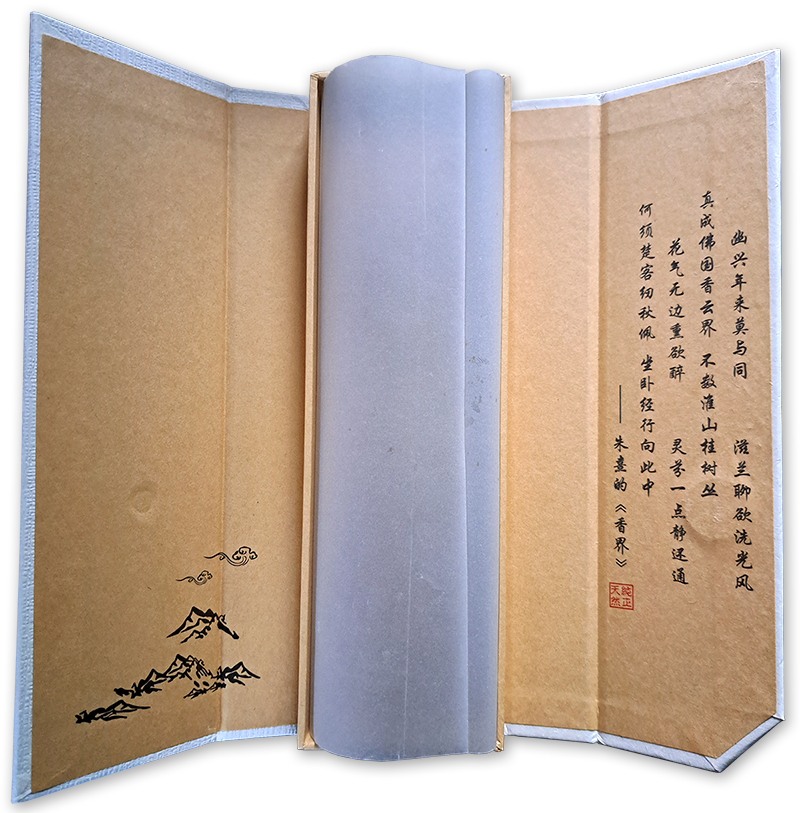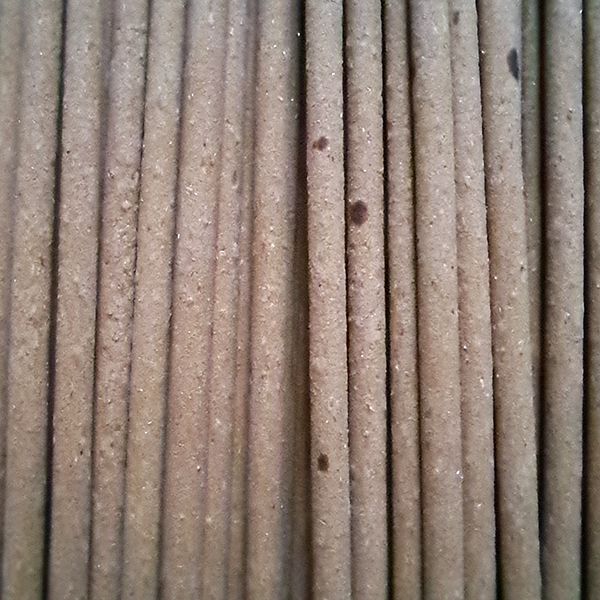Australian Sandalwood (AliExpress)
In recent years, I’ve noticed an increasing number of incense sticks (and accessories like holders) on platforms like Amazon and Etsy that appear to be resold or drop-shipped items from AliExpress. Out of curiosity, I created an AliExpress account.
It didn’t take long to find several listings for the incense sticks being reviewed here, which cost between €11 and €18 on Amazon. I chose this offer and, with a discount, paid just under €5 for the pack, which includes 120 sticks, each 21 cm long.
In addition to the Australian Sandalwood variety, there are also Sandalwood and Wormwood options. I wonder if it could actually be moxa (mugwort) which has a long tradition in TCM; both plants are part of the Artemisia genus.

The box is as high quality as the product images suggest, though there are minor differences. For instance, in my box, the inner text and painted landscape are on the respective other sides, and my box has red characters on the front that are not shown in some images.
The sticks are delicate, only about 1.5mm thick, very similar to various Japanese incense, though these are made in China.
The raw sticks have a woody, aromatic-spicy, and faintly earthy scent. When lit, the scent character remains similar, with the addition of a smoky wood note. Australian sandalwood (Santalum spicatum) has a slightly spicier character than its Indian counterpart, so I don’t doubt that Australian sandalwood is used here. However, I’ve encountered significantly better quality with a bit more sweetness and smoothness.
These Australian Sandalwood sticks offer a rather dry wood scent, and if the smoke isn’t well-diffused, its spicy nature can quickly come across as harsh and biting. When well-diluted in the air, however, they’re quite nice.
Occasionally, I’m in the mood for these kinds of scents; I then light one or two sticks in the adjoining room with the window open.
After the pack had been with me for several months, I noticed some changes in the sticks. First, tiny sparkling spots appeared, and a bit later, darker patches as though semi-liquid resin or oil was seeping from the sticks. It even left faint marks on the paper inside the box, as can be seen in the picture above.
This is how the sticks look now:

There was a post on Reddit a while ago, showing a picture of incense sticks which had developed similar spots. These were the Musk sticks out of the Hitotoki line by Kousaido. So the phenomenon is apparently not an isolated case and is not limited to cheap incense sticks.
I find these Australian Sandalwood incense sticks quite well-suited for those who enjoy spicy, wood smoke scents, especially if they’re not fond of the sweetness often found in sandalwood incense.
However, prices of €15 or more seem excessive to me.


I’m still learning about sandalwood use in incense, especially Asian incense. I note that Asian incense is very wood based – mostly sandalwood. But the sandalwood used as the combustible is mostly not that fragrant. My understanding is that the sandalwood fragrance comes from dark oils in the centre of the tree (though sometimes in circles around the centre). And that these oils are extracted, leaving pale wood with little fragrance.
Possibly what is happening here (pure speculation), is that the sticks are made up of the pale sandalwood powder, which has little fragrance, but contained within the sticks are the dark fragrant oils which make the stick smell nice when burned. And those dark spots may be some of the oils collecting together and coming to the surface.
“contained within the sticks are the dark fragrant oils” |
What I meant was essential oil made from the dark sandalwood oils. That the essential oils are possibly blended in small amounts with the pale sandalwood powder paste and the binder, and that the oil is gathering together as liquid seems to like to do, and when there is enough, the concentration will start to show up as a dark spot.
As I say, just speculation.
Where did you get that from?
Only the inner, darker wood, the heartwood, contains essential oils, the older the tree, the more fragrant it becomes.
Older wood is higher quality than younger wood.
The heartwood is extracted by carefully separating it from the sapwood. On some parts of the tree, the woods can’t be separated cleanly, this mixed wood is lesser quality.
Some companies might use this type of wood for incense. Maybe even the sapwood as a cheap base or filler material, just to be able to claim they use sandalwood. – But that’s speculation on my side.
Sandalwood EO is extracted by steam distillation. The wood left behind is very dark brown.
A lot of what I described is shown in this video:
Why Sandalwood Is So Expensive
Thanks for that link. I misunderstood something I read, and wrote the above rather poorly – conflating two things. I was aware that the pale wood had little to no fragrance, and that the dark wood / heartwood contained the oil. I had read that the wood left after oil extraction was used for incense production, and I assumed that after the oil was extracted it too would be pale. Interesting to see that it remains dark.
It doesn’t only remain dark, it becomes significantly darker. My assumption is, even though it is distilled using steam, the heat makes it go dark.
I will send you sample of spent sandalwood, Steve. It is a very interesting material.